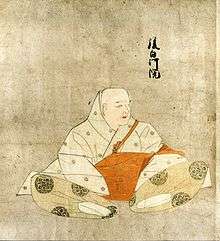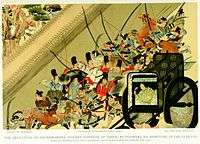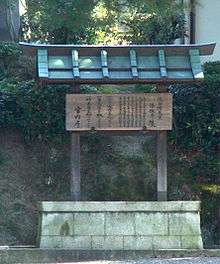Emperor Go-Shirakawa
| Go-Shirakawa | |
|---|---|
| Emperor of Japan | |
 Emperor Go-Shirakawa | |
| Reign | 1155–1158 |
| Predecessor | Konoe |
| Successor | Nijō |
| Born | October 18, 1127 |
| Died | April 26, 1192 (aged 66) |
| Burial | Hōjū-ji no Misasagi (Kyoto) |
| Spouse | Fujiwara no Kinshi |
Emperor Go-Shirakawa (後白河天皇 Go-Shirakawa-tennō) (October 18, 1127 – April 26, 1192) was the 77th emperor of Japan, according to the traditional order of succession. His reign spanned the years from 1155 through 1158.[1]
The posthumous name of this 12th-century sovereign was named after the 11th century Emperor Shirakawa, and go- (後), translates literally as "later"; and thus, he is sometimes called the "Later Emperor Shirakawa", or, in some older sources, may be identified as "Shirakawa, the second" or as "Shirakawa II."
Genealogy
Before his ascension to the Chrysanthemum Throne, his personal name (his imina)[2] was Masahito-shinnō (雅仁親王).[3]
He was the fourth son of Emperor Toba.[4] His mother was Shōko (璋子), the daughter of Fujiwara Kinzane (藤原公実)
Major consorts and children
- Empress (chūgū): Tokudaiji (Fujiwara) ??
- Consort (shinnō-hi): Minamoto Atsushiko (?) (源懿子)
- First son: Imperial Prince Morihito (守仁親王) (Emperor Nijō)
- Court Lady: Sanjō (Fujiwara) Sōko (?) (三条(藤原)琮子)
- Court Lady: Taira no Shigeko (平滋子)
- Seventh son: Imperial Prince Norihito (憲仁親王) (Emperor Takakura)
- Consort: Fujiwara Naruko ?? (藤原成子)
- Third son: Prince Mochihito (以仁王)
Events of Go-Shirakawa's life
- August 22, 1155 (Kyūju 2, 23rd day of the 7th month): Emperor Konoe died at the age of 17 years without leaving any heirs.[5]
- August 23, 1155 (Kyūju 2, 24th day of the 7th month): In the 14th year of Konoe's reign (近衛天皇十四年), the emperor died; and despite an ensuring dispute over who should follow him as sovereign, contemporary scholars then construed that the succession (senso) was received by a younger brother, the 14th son of former-Emperor Toba. Shortly thereafter, Emperor Go-Shirakawa is said to have acceded to the throne (sokui).[6]
He accumulated power steadily after the Hōgen Rebellion; his reign commenced in 1155. In 1158, he abdicated, but continued to hold power as a cloistered emperor. He attempted to decrease the influence of the Fujiwara clan and increased the power of the samurai. His policy allowed Taira no Kiyomori to seize power, and at the end of his life he allowed Minamoto no Yoritomo to establish the Kamakura shogunate in Kamakura, in the province of Sagami, modern-day Kanagawa. The establishment of the Shogunate was the beginning of samurai control of Japan for 700 years until the Meiji Restoration in the middle of the 19th century.
Retired Emperor Toba expected him to be on the throne. When his brother, Emperor Konoe, died in 1155, Go-Shirakawa became emperor with support of Toba and a powerful lord Fujiwara no Tadamichi, since they were against Retired Emperor Sutoku and did not want his son to be the next emperor. They expected Go-Shirakawa to keep the throne until his son, Prince Morihito would be old enough succeed him. The coronation of Go-Shirakawa escalated political tensions between Toba and Sutoku. At the beginning of Go-Shirakawa's reign Toba continued to reign as a cloistered emperor until his death.
- July 20, 1156 (Hōgen 1, 2nd day of the 7th month): The former-Emperor Toba died at the age of 54.[7]
In 1156 Toba died and soon afterwards the Hōgen Rebellion arose. Go-Shirakawa gained the support of samurai including Minamoto no Yoshitomo and Taira no Kiyomori, and they defeated the armies of Sutoku. After the rebellion, Go-Shirakawa ruled Japan by himself.

In 1158 he abdicated to his son Nijō and became cloistered emperor, through the reigns of five emperors (Nijō, Rokujō, Takakura, Antoku, and Go-Toba) until his death in 1192.
Taira no Kiyomori and Go-Shirakawa were on good terms initially. Kiyomori began trade with China and supported Go-Shirakawa, not just militarily but also financially. Two samurai clans, the Taira and the Minamoto, stood against each other, and the Heiji Rebellion occurred in 1159.
- 1169 (Kaō 1, 6th month): Emperor Go-Shirakawa entered the Buddhist priesthood at the age of 42. He took the Buddhist name of Gyōshin.[8]
The Minamoto lost and the Taira seized power. With Kiyomori at the peak of his power, the good relations between him and Go-Shirakawa ended. Go-Shirakawa shortly attempted a coup d'état but failed. Kiyomori imprisoned him in Toba-in, the former palace of Emperor Toba, in 1179. In 1178 Kiyomori made Prince Tokihito crown prince. Tokihito was the grandson of both Kiyomori and Go-Shirakawa; his father was Emperor Takakura, Go-Shirakawa's fourth son; and his mother was Taira no Tokuko, Kiyomori's daughter.
Shirakawa planned to regain power, and secretly sent his son Prince Mochihito to deliver a message to the Minamoto in which Go-Shirakawa proclaimed the Taira as the enemy of the Imperial court and requested that the Minamoto fight against them. In 1180 Mochihito and Minamoto no Yorimasa started the first rebellion. It failed, but several other samurai followed their attempt. In 1181 Kiyomori died and the decline of the Taira began. Go-Shirakawa began ruling again as cloistered emperor. In 1183 Minamoto no Yoshinaka from Musashi province defeated the Taira and entered Kyoto. After internal struggles within the Minamoto clan, Minamoto no Yoshitsune, a brother of Yoritomo finally destroyed the Taira clan entirely in 1185 at the Battle of Dan-no-ura.
Shirakawa came to bad terms with Yoritomo, and between them Yoshitsune was sacrificed. Yoritomo considered Yoshitsune disloyal and finally in 1189 Yoshitsune died in the battle of Mutsu province. At the same time the Ōshū Fujiwara clan, the Fujiwara clan in Mutsu province, was destroyed because they supported Yoshitsune against Yoritomo, who claimed then the title of chief of all samurai. After the death of Yoshitsune, Go-Shirakawa and Yoritomo reconciled, the former allowing the latter to found a new shogunate.

- 1192 (Kenkyū 3, 13th day of the 3rd month): The former-Emperor Go-Shirakawa died at the age of 66.[9] He had been father or grandfather to five emperors—Nijō, the 78th emperor; Rokujō, the 79th emperor; Takakura, the 80th emperor; Antoku, the 81st emperor; and Go-Toba, the 82nd emperor.[10]
The Imperial Household has designated Hōjū-ji no Misasagi at Kyoto as the emperor's official mausoleum.[11]
Kugyō
Kugyō (公卿) is a collective term for the very few most powerful men attached to the court of the Emperor of Japan in pre-Meiji eras.
In general, this elite group included only three to four men at a time. These were hereditary courtiers whose experience and background would have brought them to the pinnacle of a life's career. During Go-Shirakawa's reign, this apex of the Daijō-kan included:
- Kampaku, Fujiwara Tadamichi, 1099–1164.[5]
- Daijō-daijin, Sanjō Saneyuki, 1079–1162.[5]
- Sadaijin, Fujiwara Yorinaga, 1120–1156.[5]
- Udaijin
- Nadaijin
- Dainagon
Eras of Go-Shirakawa's reign
The years of Go-Shirakawa's reign are more specifically identified by more than one era name or nengō.[12]
See also
Notes
- ↑ Titsingh, Isaac. (1834). Annales des empereurs du Japon, pp. 188–190; Brown, Delmer et al. (1979). Gukanshō, pp. 326–327; Varley, H. Paul. (1980). Jinnō Shōtōki. pp.205–208.
- ↑ Brown, pp. 264; n.b., up until the time of Emperor Jomei, the personal names of the emperors (their imina) were very long and people did not generally use them. The number of characters in each name diminished after Jomei's reign.
- ↑ Titsingh, p. 188; Brown, p. 326; Varley, p. 205.
- ↑ Titsingh, p. 190.
- 1 2 3 4 Brown, p. 326.
- ↑ Titsingh, Isaac. (1834). Annales des empereurs du japon, p. 189. , p. 189, at Google Books; Brown, Delmer et al. (1979). Gukanshō, p. 326; Varley, H. Paul. (1980). Jinnō Shōtōki, p. 44; a distinct act of senso is unrecognized prior to Emperor Tenji; and all sovereigns except Jitō, Yōzei, Go-Toba, and Fushimi have senso and sokui in the same year until the reign of Emperor Go-Murakami.
- ↑ Keene, p. 616. , p. 616, at Google Books; Kitagawa, p. 783; Brown, p. 327.
- ↑ [see above]
- ↑ Brown, p. 327; Kitagawa et al. (1975). The Tale of the Heike, p. 788.
- ↑ Varley, p. 208.
- ↑ Ponsonby-Fane, Richard. (1959). The Imperial House of Japan, p. 421.
- ↑ Titsingh, pp. 188–194; Brown, pp. 326–327.
References
- Brown, Delmer M. and Ichirō Ishida, eds. (1979). Gukanshō: The Future and the Past. Berkeley: University of California Press. ISBN 978-0-520-03460-0; OCLC 251325323
- Helmolt, Hans Ferdinand and James Bryce Bryce. (1907). The World's History: A Survey of Man's Progress. Vol. 2. London: William Heinemann.OCLC 20279012
- Kitagawa, Hiroshi and Burce T. Tsuchida, ed. (1975). The Tale of the Heike. Tokyo: University of Tokyo Press. ISBN 0-86008-128-1 OCLC 164803926
- Ponsonby-Fane, Richard Arthur Brabazon. (1959). The Imperial House of Japan. Kyoto: Ponsonby Memorial Society. OCLC 194887
- Titsingh, Isaac. (1834). Nihon Odai Ichiran; ou, Annales des empereurs du Japon. Paris: Royal Asiatic Society, Oriental Translation Fund of Great Britain and Ireland. OCLC 5850691
- Varley, H. Paul. (1980). Jinnō Shōtōki: A Chronicle of Gods and Sovereigns. New York: Columbia University Press. ISBN 978-0-231-04940-5; OCLC 59145842
| Regnal titles | ||
|---|---|---|
| Preceded by Emperor Konoe |
Emperor of Japan: Go-Shirawaka 1155–1158 |
Succeeded by Emperor Nijō |
